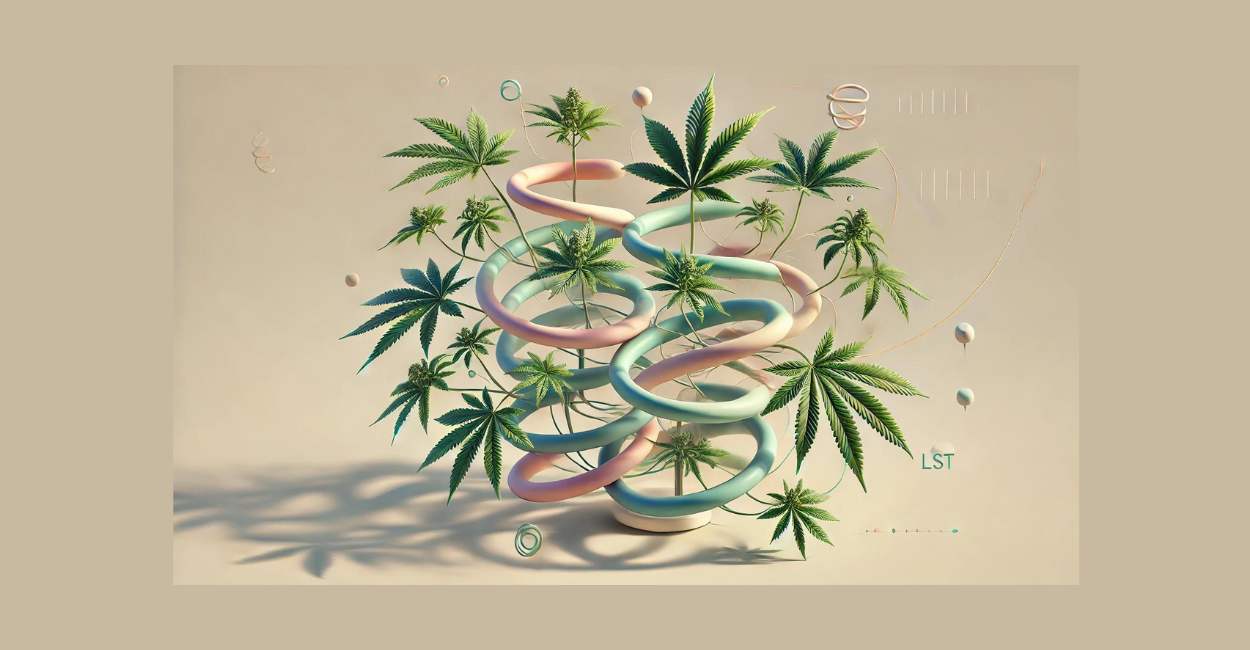Reading time: 4-5 minutes
Low-Stress Training (LST) is a proven method to control the growth of cannabis plants and maximize their yield. While the basics of LST are accessible to beginners, advanced LST offers a wealth of possibilities that go beyond simply bending and securing branches. In this article, we will explore advanced techniques such as the spiral method, which is particularly favored by our team. These techniques not only help to increase yields but also offer innovative solutions for specific challenges in cultivation, such as adhering to the three-plant rule.
Table of Contents
What is Advanced Low-Stress Training?
Advanced Low-Stress Training (LST) goes beyond simple branch bending and securing. It combines multiple techniques to optimally control the plant’s growth, efficiently use light, and maximize yield. It is particularly important to understand the physiological needs of the plant and to manipulate them strategically.
The Spiral Technique: Our Team Favorite
In our team, we are big fans of the spiral technique. This method not only provides a creative way to optimize space in the grow room but can also be a clever method when dealing with the three-plant rule. By intertwining multiple plants, it can appear as if there is only one plant when in fact several plants are growing together. However, this requires skill and experience to ensure that all plants receive enough light and nutrients.
Benefits of the Spiral Technique
- Space-saving: The spiral technique allows for the cultivation of multiple plants in a small space without them shading each other.
- Creative use of space: This technique is particularly useful in small grow rooms or grow boxes where available space must be maximized.
- Potential to bypass the three-plant rule: By intertwining plants, it can give the impression that there is only one plant when there are actually several.
- Improved light distribution: By arranging the branches in a spiral, you ensure that all parts of the plant receive even light exposure.
Guide to the Spiral Technique
To successfully apply the spiral technique, follow these steps:
- Prepare the plants: Start with young plants that are still flexible enough to be shaped into a spiral. Remove larger leaves to facilitate access to the branches.
- Shape the branches: Begin by guiding the main stems and branches in a spiral around the main stem. Use gentle plant ties or flexible wires to hold the branches in place.
- Fixation: Ensure that you regularly secure the branches so that they stay in the desired shape. Regularly check the ties to make sure they aren’t too tight, which could damage the plant.
- Care: Monitor the plant closely during growth and make sure that all areas receive even light exposure. Adjust the spiral shape as needed to optimize light distribution.
Other Advanced LST Techniques
In addition to the spiral technique, there are other advanced methods that help maximize the yield and quality of your cannabis plants.
1. Combining LST and High-Stress Training (HST)
By combining LST with high-stress training techniques, you can more precisely control your plants' growth. While LST is gentle on the plant, HST techniques like topping or fimming can promote the growth of new main colas.
2. Net Methods: Screen of Green (ScrOG)
The ScrOG technique combines LST with a horizontal net to keep the plants in a flat plane. This maximizes light exposure and leads to evenly growing bud sites.
3. LST Combined with Hydroponics
In hydroponic systems, plants respond particularly quickly to LST, which can result in more intensive bud formation. Combining LST with hydroponic systems allows for more precise control over plant growth.
Important Note:
Low-Stress Training (LST) is also highly suitable for autoflowering cannabis plants, despite their shorter lifecycle. Since autoflowers do not respond to the light cycle but enter the flowering stage after a set period, it is crucial to start LST early. By carefully bending and securing the branches during the first few weeks of growth, you can optimize light distribution across all bud sites, leading to a better harvest. However, it is important to be gentle and patient as autoflowers are more sensitive to stress. For more tips on caring for and training autoflowering cannabis plants, check out our article Training Autoflowering Cannabis: A Beginner's Guide.
Tips for Success with Advanced LST
- Patience: LST requires time and patience. Don’t rush and regularly check how the plants are developing.
- Gentle handling: Be careful not to damage the plants. Use soft ties and gently secure the branches.
- Combining techniques: Experiment with different LST techniques and find out which combination works best for your growing conditions.
Conclusion: Advanced LST for Maximum Yields
Advanced Low-Stress Training offers a wealth of possibilities to maximize the yield and quality of your cannabis plants. The spiral technique is one of our preferred methods to efficiently use space and find creative solutions for legal challenges. By combining LST with other techniques and closely monitoring your plants' growing conditions, you can achieve impressive results and unlock your plants' full potential.
Experiment with these advanced techniques and discover how you can get the most out of your growing system. We at Cannoptikum are convinced that LST is one of the most effective ways to maximize yields and promote the health of your plants.
Disclaimer
This website's content is for informational use only and should not be considered medical or legal advice. Always consult a healthcare professional for health-related issues. Be aware of local regulations regarding cannabis cultivation. We are not liable for any actions taken based on this information.

